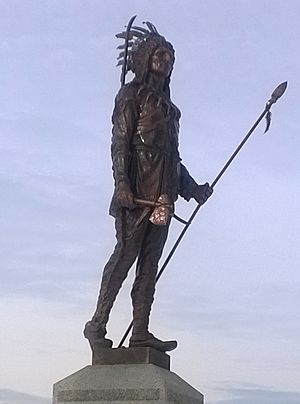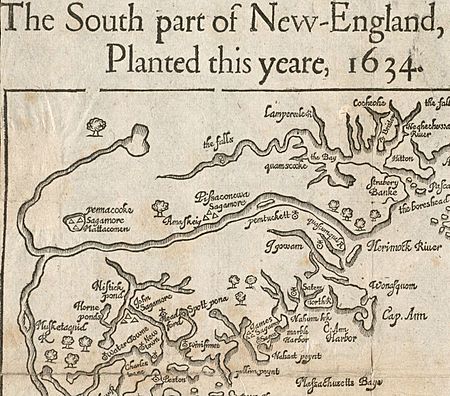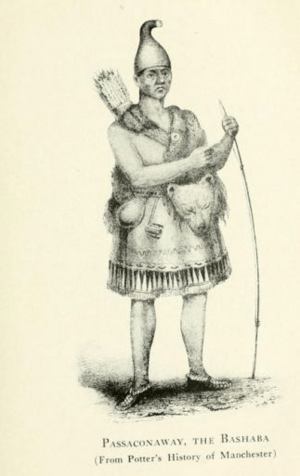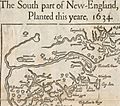Passaconaway facts for kids

Passaconaway was a very important leader, known as a sachem (chief) and later a bashaba (chief of chiefs), of the Pennacook people. They lived in what is now southern New Hampshire in the United States during the 1600s. Passaconaway was famous for his dealings with the early English settlements, like the Plimouth and Massachusetts Bay Colonies.
Contents
What's in a Name?
Passaconaway's name was written in many different ways in old records. Some spellings include Papisseconewa, Passeconneway, and Peasconaway. In the 1800s, some people thought his name meant "child of the bear." This idea came from combining two Native American words: papoeis (meaning "a child") and kunnaway (meaning "a bear").
However, experts today think this translation is probably not correct. We don't have any old records that explain what his name truly meant. It's also unclear if his name was related to his family, his role as a spiritual leader, or something else.
Passaconaway's Life and Leadership
Passaconaway was born sometime between 1550 and 1570 and passed away by 1669. During his long life, English settlers began arriving in New England. This was a time of big changes for Native American communities. There were wars over the fur trade and terrible diseases brought by Europeans, which greatly reduced the Native population. Because of these challenges, some Native leaders, including Passaconaway, sometimes allowed English settlers to live on their lands. They hoped to form alliances against other Native groups who were attacking them.
Passaconaway was also a powerful powow, which was a spiritual leader and healer. English settlers, even those who didn't understand his powers, respected him. They wrote that he could do amazing things, like make water burn or create ice in summer!
He lived in the Pennacook territories around the Merrimack River, moving between different village sites like Amoskeag and Pawtucket. These moves were part of the traditional Native American way of life, following the seasons for fishing and planting. Records show he lived near the Pawtucket Falls (which is now Lowell, Massachusetts).
Passaconaway became the sachem (chief) of the Pennacook. Eventually, he became the bashaba (chief of chiefs) of a large group of tribes. These tribes joined together for protection from other Native groups, like the Tarrantines and the Mohawks. Passaconaway was one of the first Native leaders to lease land to English settlers. He hoped these agreements would create alliances to protect his people. However, dealing with the English was often difficult, and Passaconaway frequently faced challenges to his authority.
In 1642, a false rumor spread that Native Americans were planning against the English. A group of soldiers went to arrest Passaconaway and take his weapons. When a thunderstorm stopped them, they instead captured his son, Wonalancet, his daughter-in-law, and his grandchild. After Boston authorities apologized and freed his family, Passaconaway gave up his guns.
In 1648, an English missionary named John Eliot visited Passaconaway. Eliot preached to him, and Passaconaway seemed open to his message. He even invited Eliot to live with the Pennacook, though Eliot did not. While it's not clear if Passaconaway became a Christian, his son Wonalancet did.
Passaconaway's Later Years and Legacy
Around 1660, Passaconaway decided to step down as leader. He chose his second son, Wonalancet, to be the next sachem of the Pennacook. Passaconaway gave a famous speech, urging his people to always live in peace with the English colonists.
As he grew older, Passaconaway's people faced many challenges. Traditional ways of life became harder due to English laws and settlements. In 1664, he even had to ask the colonial government for a land grant for territory he once ruled. In 1665, his daughter, Bess, sold some Pennacook land to an English captain. By this time, many Pennacook and Pawtucket families had been arrested or even sent away.
The exact details of Passaconaway's death are not known. His son, Wonalancet, continued his father's peaceful policies, even during King Philip's War. However, Passaconaway's grandson, Kancamagus, who became sachem after Wonalancet, chose to fight back against the English. Kancamagus eventually moved the remaining Pennacook people north to Canada.
Passaconaway is remembered today as a "good" Indian by many non-Native people. This is mainly because he always tried to keep peace with the English. He is honored in various places in New Hampshire and beyond.
Stories and Legends
Many stories and legends about Passaconaway come from old colonial accounts. One story says that before the Pilgrims arrived, a European ship captain saw a huge Native American standing on a cliff, who he thought was Passaconaway.
Another legend tells that the Wampanoag chief Massasoit asked Passaconaway to use his powers to get rid of the Pilgrims. But at Massasoit's village, Passaconaway couldn't create a storm for the first time ever. After talking with the Great Spirit, Passaconaway declared that the Great Spirit wanted him to live in peace with the English. From then on, he told his people and other tribes to never fight the European settlers.
Local New Hampshire stories say that in 1647, John Eliot tried many times to meet Passaconaway before finally being allowed to speak with him. Legend says that after Eliot suddenly died, Passaconaway decided to step down as chief. He announced that his son Wonalancet would be the new sachem, urging his people to keep peace.
It's important to know that some images of Passaconaway are not historically accurate. For example, the statue in Edson Cemetery in Lowell, Massachusetts, shows him in clothing and a headdress from Plains Indian tribes, not the Pennacook.
Legends about Passaconaway's death say he was buried in a cave on Mount Agamenticus in Maine. Some stories claim his spirit was carried up to Mount Washington (Agiocochook), a sacred mountain, on a sled pulled by wolves. There, he supposedly burst into flames and went to live with the Great Spirit. These dramatic stories likely mix up Passaconaway with another figure, St. Aspinquid, and add details from later times.
Passaconaway likely died and was buried near an island in the Merrimack River where he was last known to be living.
Places Named After Passaconaway
- Village of Passaconaway: The Kancamagus Highway, a scenic road through the White Mountains of New Hampshire, passes by the former village of Passaconaway. This area once had a sawmill, hotel, and farms. Today, it's known for hiking and skiing trails. The U.S. Forest Service maintains the Passaconaway Campground and the historic Russell-Colbath House here.
- Mount Passaconaway: A mountain in the Sandwich Range of the White Mountains is named after the sachem. It stands about 4,043 feet tall.
How He is Remembered Today
The Daniel Webster Council of the Boy Scouts of America honors Passaconaway. They named their Order of the Arrow lodge, a special group within scouting, after him.
Images for kids
-
A statue of Passaconaway, standing in Edson Cemetery, Lowell, Massachusetts.






